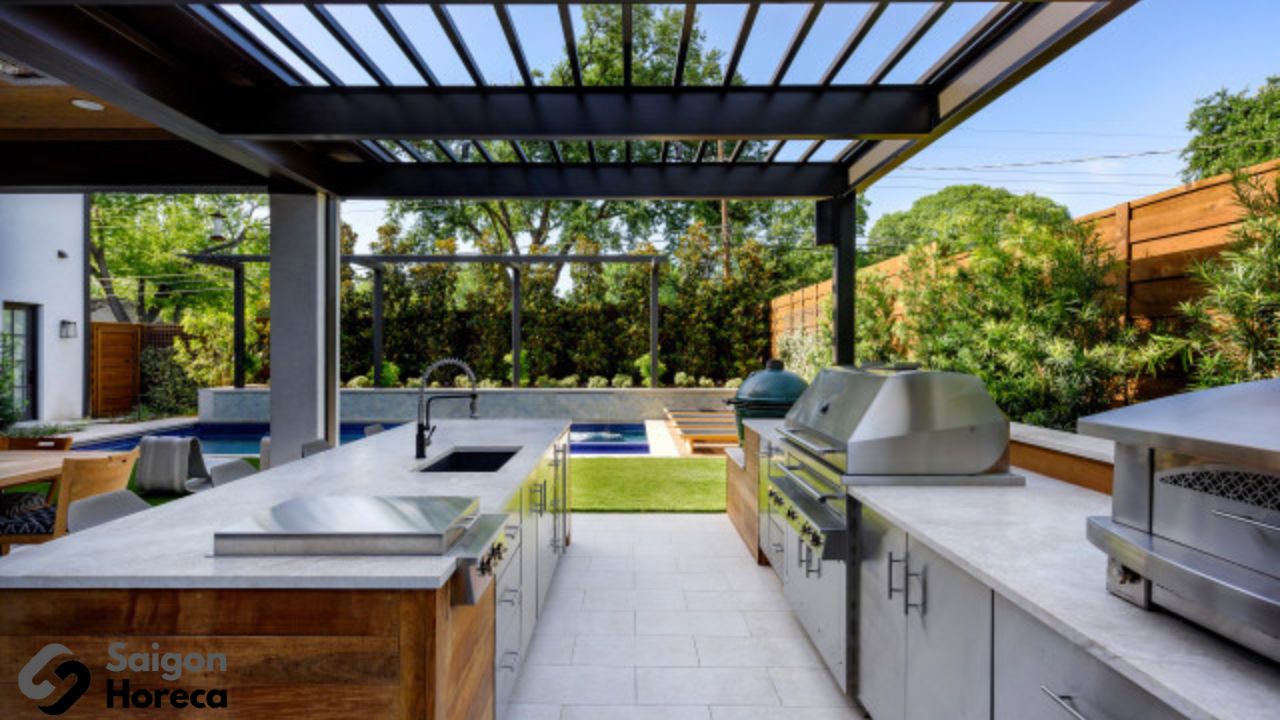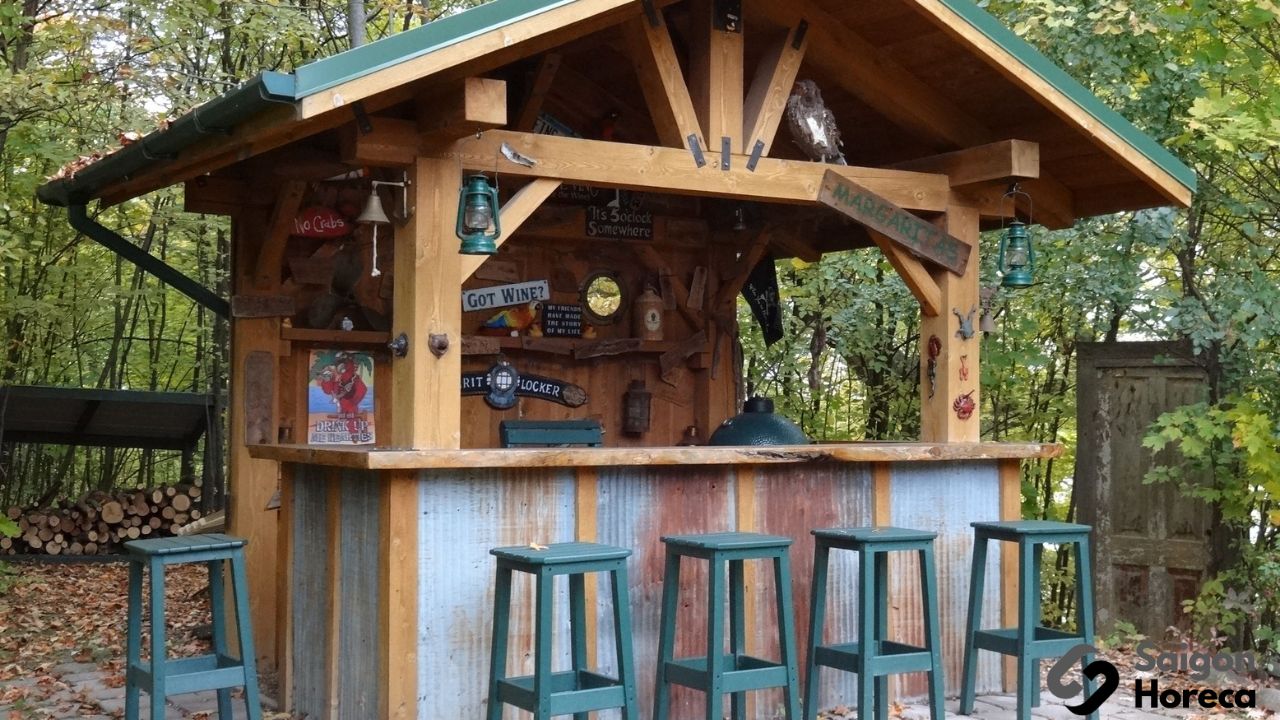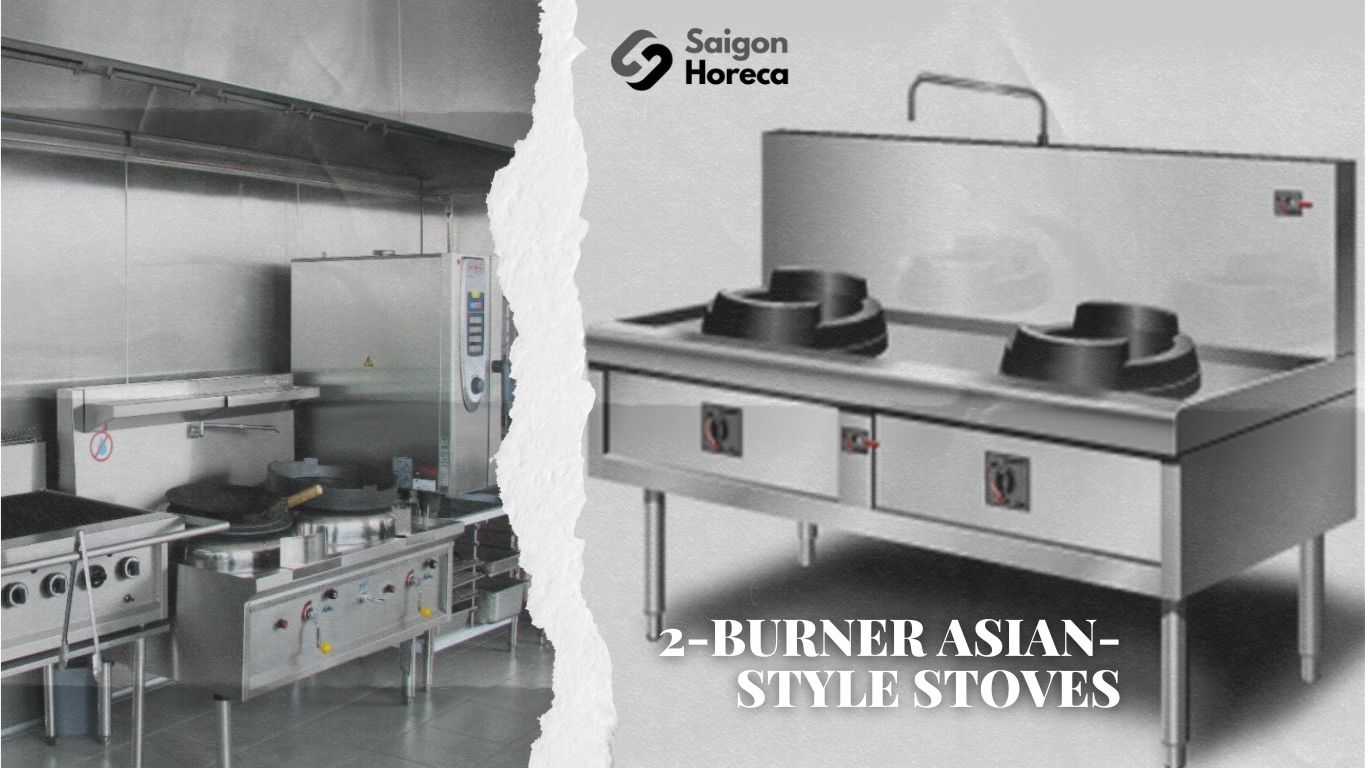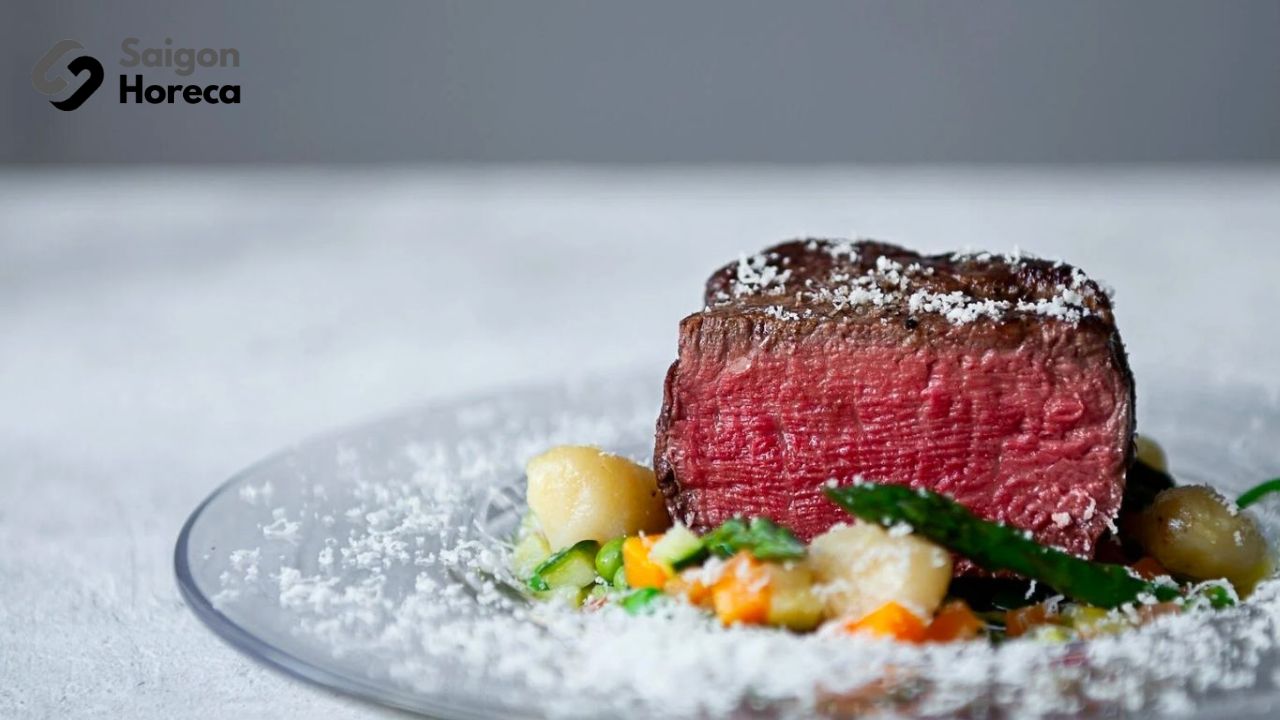Welcome, readers, to our article where we will explore the world of high-end industrial kitchens through a comprehensive and detailed […]
Read More

- Bar & Coffee Equipment
5 Keys for a Successful Outdoor Bar Design Plan
- October 25, 2023
Outdoor bars are becoming increasingly popular and appealing destinations for socializing. With the ability to enjoy natural surroundings and fresh air, these bars offer not only a fantastic relaxation spot but also a place to connect and spend quality time with friends and family. In this article, Saigon Horeca will accompany you on a creative and enticing journey to explore the art of outdoor bar design. Our aim is to help you create a unique and alluring space that attracts customers and provides memorable experiences.
In this article
Key Aspects to Consider When Designing an Outdoor Bar
Choosing High-Quality Materials for Bar Design
Selecting materials for bar design is an important and meticulous step, especially when it comes to an outdoor bar. We must ensure that the chosen material not only creates an engaging environment but also possesses high durability, especially in the face of harsh weather conditions.
Currently, for designing a bar counter in a café, three common and favored materials are wood, stone, and metal. Each of these materials brings a distinct style to the bar counter and contributes to the café’s overall appeal.
Wooden Bar Design: Wood, whether natural or industrial, always carries a sense of natural beauty and rustic charm. The warmth and closeness to nature when using wood are the strengths of this choice. Designing a bar counter with wood is also easy to blend with other interior elements, creating a friendly and cozy space.
The type of wood you use is a prime example. Choose wood with durability and resistance to moisture to ensure the product maintains its beauty and quality over time. This not only creates a natural beauty but also ensures the sustainability of the bar.
Stone Bar Design: Stone materials with polished surfaces create an elegant and clean look for the bar counter. Their excellent load-bearing capacity and waterproof properties make maintenance and cleaning convenient. Typically, covering the counter’s surface with stone is enough to make it a focal point, while other parts can use tiles or plaster. In terms of decoration, you can use paint, artwork, or decorative tiles, depending on your desired design style.
Metal Bar Design: Using stainless steel or solid aluminum brings a modern and robust appearance. Shaping with square blocks and metal materials creates a strong impression for the bar counter. This style often suits cafes with an “industrial” design. The cool colors of metal, especially black, can create an image of power, elegance, and mystique. Another option is to use copper or gold-plated metal to create a dazzling and seductive image for the café.


Creating a Harmonious Design Style for Outdoor Bar Spaces
The next important consideration is choosing a design style that suits the outdoor space. This process depends on the investor’s preferences and how the outdoor area is arranged. The goal is to ensure that the bar design style harmonizes perfectly with the overall space, creating a unified and harmonious picture. Typically, many investors lean towards a modern and creative style for their design.
When deciding on the design style for an outdoor bar, it’s important to consider various factors to ensure harmony and suitability with your outdoor space. Here are some ways to arrange furniture and tips for choosing:
Pay attention to the flow of both customers and staff, as this is crucial in the effective design of an outdoor bar. The comfort and efficiency of an outdoor bar largely depend on how you arrange the space to cater to both parties.
- The customer flow typically starts from the entrance and moves through the order counter, payment counter, waiting area, drink pickup counter, and then to the seating area (if customers choose to stay) before heading back to the entrance. This is especially important for cafes with a counter service and payment setup.
- The staff flow usually goes from the order counter to the payment counter, beverage preparation area, and then to the customer service counter. To optimize efficiency, you need to consider how to organize equipment and objects so that staff can move easily and efficiently. Minimize unnecessary back-and-forth movement to save time and effort.
Additionally, the layout of objects and equipment based on the work process is another critical aspect. Classify and arrange equipment according to the beverage preparation steps to ensure staff don’t get overwhelmed, and work proceeds smoothly. An example is arranging equipment such as order screens, coffee bean grinders, coffee makers, milk frothers, paper cups, lids, and straws in a logical sequence to avoid workflow congestion in the bar area.
Aside from these factors, hygiene is an aspect that cannot be overlooked. Ensure that the bar is always clean and tidy to satisfy customers. Use sealed trash cans to keep the environment clean and prevent litter from scattering. Place trash cans away from areas where fresh food is stored. Lastly, turn shelves and objects into pieces of art to create beautiful and creative focal points in your bar space. Avoid creating a cramped space by utilizing every nook effectively.
Most importantly, choose a design style that aligns with your business goals, the preferences of your target audience, and the characteristics of your outdoor space. Consulting with a professional interior designer can help you ensure the harmony and success of your outdoor bar design project.
Interior Design for Outdoor Bars
Designing the interior is a crucial aspect of creating an inviting and comfortable outdoor bar space for customers. Here are some key points to consider:
Simple and Quality Design: For outdoor bars, simplicity is often an advantage. Select essential pieces of furniture and avoid unnecessary clutter. Choose furniture with high-quality materials to ensure durability and long-lasting quality.
Material Selection: Choose interior materials that are suitable for the outdoor environment. Common choices include waterproof wood, rust-resistant metals, and outdoor cushions that can withstand sun and rain. This helps ensure that the furniture maintains its beauty and durability in all weather conditions.
Scientific and Harmonious Arrangement: The arrangement of interior furniture should follow a well-thought-out and harmonious plan. Ensure that tables, chairs, and other furnishings are arranged for a comfortable and easy flow. Consider creating different “zones,” such as seating areas, waiting areas, and payment areas.
Tasteful Decoration: Use decorations to create focal points and establish a unique atmosphere for the bar. Plants, decorative lighting, art, or sculptures can contribute to a distinctive and visually pleasing space.
Integration with the Natural Environment: Outdoor spaces are typically designed to enjoy natural light and fresh air. Establish a connection with the environment by using natural colors and materials that resonate with nature.
Interior design for an outdoor bar should prioritize aesthetics, comfort, and convenience for customers. This helps create an attractive and enjoyable outdoor bar space.


Standard Dimensions for Bar Installation and Construction
In bar design, three main types are L-shaped, U-shaped, and C-shaped bars, each with its own advantages, suitable for different types of coffee shops or bars. However, the size of the bar is also important and depends on the design style and business goals of the establishment. Here are some guidelines on bar dimensions and other important aspects:
Customer-Facing Area Dimensions:
- Height of the customer-facing area: Typically ranges from 1 meter to 1.2 meters. This height allows customers to easily communicate with staff and place orders conveniently.
- This size helps prevent customers from feeling “shorter” than the staff, making the ordering experience comfortable.
Employee Working Area Dimensions:
- The height of the employee working area should be between 80 cm and 90 cm. This allows staff to work without needing to bend or strain, facilitating efficient bartending and service.
- The employee work area should be suitable for the height of the staff, enhancing work efficiency and reducing fatigue during long working hours.
Interior Bar Counter Space Dimensions:
- A bar counter typically accommodates 2-4 employees working simultaneously. Therefore, the interior bar counter space needs to be spacious enough for movement, cleaning, and efficient work.
- The minimum width of this area should be 120 cm (excluding space for cabinets, shelves, and the counter). A spacious area helps staff work comfortably and efficiently.
Choosing the right design style and size will help create an effective, comfortable bar counter that aligns with the business goals of the establishment.
Color and Lighting in Bar Design
Color and lighting are two important elements in creating an attractive and comfortable outdoor bar space. Here are some tips on using color and lighting in the design:
Color:
- Prioritize the use of bright and vibrant colors such as green, blue, orange, and light pink. These colors often create a sense of joy, freshness, and familiarity for customers.
- Consider using colorful details as accents, such as chairs or decorative lights. This can add attractiveness and uniqueness to the space.
Lighting:
- Avoid using overly bright and dazzling lights, especially lights that cause glare during the daytime. Instead, choose soft and gradual lighting to create a warm and comfortable atmosphere.
- Use decorative lights like table lamps, pendant lights, or candles to create a cozier and more romantic ambiance in the evening.
- If the bar is located near an area with natural light, take advantage of daylight to create an open and comfortable space during the day.
In summary, the use of color and lighting in an outdoor bar should create a cheerful, comfortable, and appealing space for customers. Thoughtful use of color and lighting can result in an exciting and unique experience for your customers.
To explore how renowned bars have implemented these strategies to create unique spaces and to receive creative suggestions for applying them in your own bar design project, read on to start the journey of crafting a distinctive and impressive bar space: Techniques for Creating Impression and Creativity in Bar Design Styles
Impressive Outdoor Bar Design Examples
Designing an outdoor bar can encompass various styles, depending on the owner’s preferences, business goals, and the specific space.
Natural and Creative Style:
Designing an outdoor bar can take on a variety of styles, and one popular choice is the natural and creative style. In this style, the use of natural materials like wood and stone can create a bar with a close connection to nature. This is an excellent choice for bars situated in environments with existing greenery and foliage. Surrounding the bar with plants can provide a comfortable, refreshing, and exciting atmosphere for customers.
Lighting in this style is usually soft and gradual, creating a warm and inviting space at night. Decorative lighting elements, like elegant pendant lights and handcrafted sea-inspired accessories, can be used to add intrigue and a creative, friendly atmosphere. The natural and creative style is a perfect choice for those who appreciate the fusion of human and natural elements, turning the outdoor bar into a unique and captivating destination.
Beach and Island Style:
The beach and island style is another exciting choice for outdoor bar design. To evoke that beachy feel, use colors like sky blue and sandy beige to create a unique and relaxing atmosphere. Materials like waterproof wood and weather-resistant components are smart choices for durability in the harsh outdoor environment.
Decor in the beach and island style often involves sea-related accessories such as elegant hanging lights and handcrafted details featuring marine life or sea symbols. This creates an intriguing and appealing space, helping customers feel the ocean’s embrace right at the bar. This style can make the bar an ideal destination for those who want to enjoy the feel of the beach without being near the actual shoreline.
Modern and Elegant Style:
The modern and elegant style is a fitting choice for those who prefer simplicity and sophistication. To create a bar in this style, use industrial materials like metal, glass, and stone to achieve a modern and sophisticated ambiance. Combining these materials can result in a unique and attractive space.
Lighting plays a crucial role in this style. Employ LED lights and decorative spotlights to create highlights and make the bar space stand out. Thoughtfully arranged lighting details can establish an elegant and stylish atmosphere.
Furniture arrangement is also significant. Using metal or wood chairs and tables can add versatility and comfort for customers. Simple and modern design patterns can turn the bar into an elegant and upscale destination.
Traditional and Vintage Style:
The traditional and vintage style blends history with comfort. To create a bar in this style, use wood and traditional details like ceramic dishes, cork stoppers, or vintage lamps to establish a cozy, vintage atmosphere. Elements like lamps and stoppers can evoke a classic and sophisticated feel.
Arranging plenty of plants and flowers can create a natural and inviting atmosphere. Vibrantly colored plants can offer a refreshing and exciting environment. Utilize wooden chairs and tables with traditional patterns to make a statement. This design often features intricate shapes and decorative elements, producing a space that is both refined and warm for customers.
Remember, the most important thing is to create a comfortable, attractive, and fitting space for your business. Choose a design style that aligns with your preferences and the environment.
Monday - Friday
from 8h00 to 18h00
Số 40 Đường số 6, KDC Melosa Khang Điền, Phú Hữu, HCM.
Contact anytime
If you’re seeking an engaging method to delve into the world of culinary art or wish to share unique gastronomic […]
Read More




